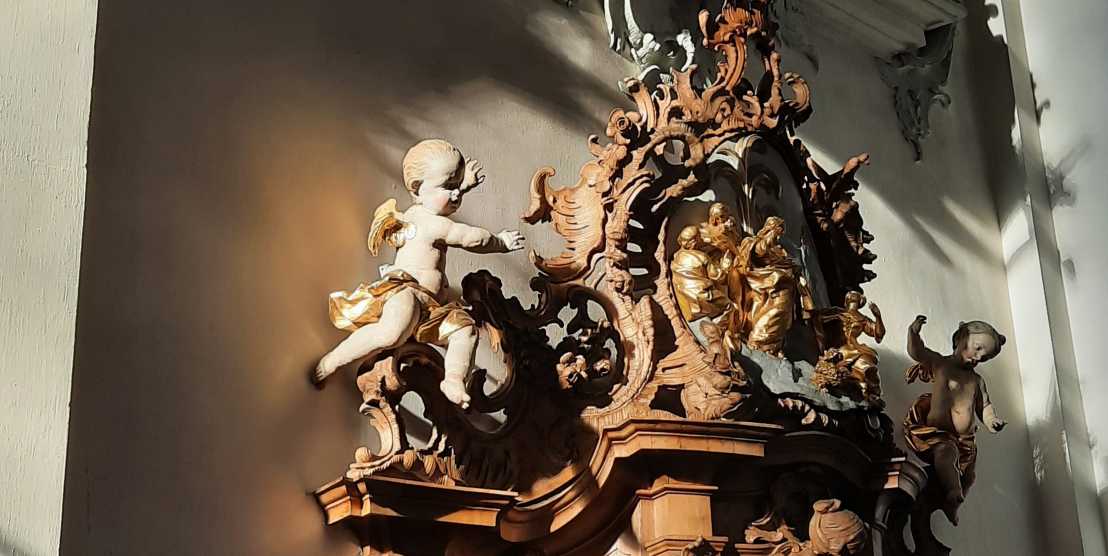Two PhD Students in Swiss Rococo Architectural and Art History
The Chair for the History and Theory of Architecture (Prof. Dr. Maarten Delbeke) is looking for two doctoral students to join the team for the SNSF Project “Swiss Rococo Cultures: Idioms of ornament and the architecture of East Switzerland (1700-1850)” to start in early 2025.

This project studies the architecture and material culture of East Switzerland and specifically the cantons of St. Gallen and Appenzell Innerrhoden and Ausserrhoden in the 18th and early-19th centuries to understand how the Rococo was adopted by different social classes and groups and generated multiple idioms of ornament. The study combines objects of art and architecture with folk art and everyday material culture. Methodologically it blends approaches from art and architectural history and ethnography with a digital research platform.
At the epicenter of Swiss proto-industrialization and subject to renewed campaigns of confessionalization, East Switzerland in the 18th century was a region divided by class and confession. At the same time, it was unified by a nearly unanimous adoption of the Rococo repertoire across different objects and buildings, from monumental churches to farmhouse furniture. The project hypothesizes that this broad dissemination of the style should not be read simply as the result of some cultural hegemony, as is often assumed by the existing literature, but rather as different social classes actively adapting it to their circumstances, views and aspirations, thus generating distinct and culturally embedded ornamental idioms.
The project’s main points of entry will be (1) to trace how certain decorative patterns moved from one object or medium to another and how they transformed in the process and (2) to examine how various groups appropriated, disseminated, and transformed those patterns.
The project thus aims to answer the following questions:
1) What were the media (prints, objects, etc.) through which this dissemination happened?
2) What was the role of itinerant craftspeople, wealthy patrons (religious or social elites), and the new consumer public of the middle and lower classes?
3) What did the ornamental forms of the Rococo mean for each of these groups? What kinds of iconographies and symbols did they accommodate?
4) Why did the Rococo remain tenaciously present in East Switzerland until the 19th century?
5) When and why was this broad spectrum of architecture and material culture divided into “high art” and “folk art”?
Job description
- Individual research within the framework of the research project, resulting in a PhD
- Participation in, and support of, research, publication and outreach activities of the research group
- Participation in the PhD program of the Institute
- Participation in the teaching activities of the chair
Profile
- MSc or MA in architecture, the history of architecture, art history, or a related field
- Experience in historical research and academic writing
- Familiarity with the history of art and architecture in the 18th century, and with Rococo in particular, is advantageous
- Familiarity with the history, architecture and geography of the region under study is advantageous but not required
- In addition to English fluency, advanced German language skills are required. Swiss-German dialect abilities are advantageous, but not required
- Ability to work in a team, interact with different project partners (museums, archives, private collections, experts and academics from different fields and geographies), communicate your research to different audiences
- Willingness to move to Zurich for the duration of the project
- A clear interest in a long-term career in research
We offer
- 100% doctoral salary (ETH standard rate) for the 3.5-year duration of the project
- Participation in the doctoral program of the gta
- Academic supervision and mentoring by members of our chair, within a developed research framework (including guidance towards specific methods, materials and bibliography)
- Contact with our network of Swiss experts
- Guidance in writing, publishing and career development
Additionally, we offer a high-quality research environment, an engaged and enthusiastic team, excellent research infrastructure and a workplace on the ETH Hönggerberg campus in Zurich, opportunities to interact with colleagues and experts of various fields in an open and inclusive environment, many cultural and scientific events within the Institute and Department, and excellent working conditions provided by ETH.
Curious? So are we...
We look forward to receiving your online application with the following documents
- Cover letter (maximum one page)
- CV (maximum 5 pages, no design portfolios)
- Two references (email addresses, not cover letters)
- Writing sample (MA Thesis, publication, or anything similar)
- Research proposal that fits in the framework of the Project (max. 2 pages excluding illustrations, plus a short bibliography)*
*For this proposal, we are interested in how you would approach the topic of the Project. Any way to relate this to current discussions about gender, class, coloniality, environment, religion and aesthetics would be welcome. This proposal will serve as the starting point for our conversation about your qualifications and interests. If you are accepted, we will help you develop your own dissertation project.
Timeline
- Deadline for Applications: January 6, 2025
- Applicants will be notified about whether they will be interviewed by January 13, 2025
- Applicants accepted for an interview will have to provide a letter of recommendation by January 20, 2025
- Interviews will take place via zoom on January 20-21, 2025
- Accepted applicants will be expected to start work in Zurich by February 17, 2025 or by arrangement
Please note that we exclusively accept applications submitted through our online application portal. Applications via email or postal services will not be considered.
Further information about the Chair for the History and Theory of Architecture can be found on our website. Questions regarding the position should be directed to Dr. Noelle Paulson, (no applications).